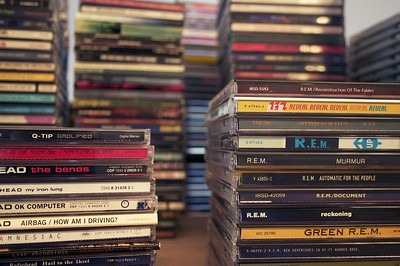In defence of owning albums
Ironically, I began writing this article while streaming boygenius’ the record on Spotify. In the run-up to the Grammys, I have taken to listening to a fair few of the nominated records. Streaming unfamiliar albums makes it easy for me to dip my toes into new genres and artists and allows me to find my favourite nominees this year. I would be lying if I said I didn’t enjoy streaming’s convenience, and how incredibly easy it is to listen to such a wide variety of music, anywhere and anytime. Spotify definitely has its place.
Despite this, I have found that streaming music frames an album differently for me. I plug in my headphones, open the Spotify app on my phone, and often go about my day with music absent-mindedly blasting in my ears – just because it’s convenient and just because it’s there.
Listening to a physical album via CDs or vinyl is the best way to consume music
However, when I take the time and the dedicated decision to sit down and put a CD in my player, the experience of listening to an artist’s work is so much more intense, intimate, and enriching. I must not be the only person who believes this – the Guardian reported that sales of CDs rose by 2% in 2023 and that vinyl rose 12% in volume in the same year. The demand for physical music is clearly growing, but in an age of technology, it at first glance seems unclear why.
For me, listening to a physical album via CDs or vinyl is the best way to consume music. The music is confined to my bedroom, my own personal and familiar space, and this makes me feel like I am in closer proximity to an artist and their creative message. The distractions of the outside world are shut out, and I am invited to pay more attention to the intricacies of songwriting and music production. There is something special about music being physically embedded in your own space.
Owning music forces us to pay attention. When we buy a copy of an artist’s work, we not only put in a monetary investment, but we expect to sit with the record, re-listen to the lyrics, and understand the sonic progression within the album. Even the framing of an album changes. Personally, in my mission to understand the artist’s vision for the record, I pay more attention to cover art, the ordering of tracks, and even seemingly insignificant details like the fonts chosen on the back cover. The physical album acts as a self-enclosed unit, with so many more small details than streaming could ever include, that allows the listener to fully appreciate the artistry. The physical album stands alone, not surrounded by adverts or suggestions for further listening, offering the listener a deep and unique experience.
The beauty of physical records comes from this contrast between streaming and owning albums
Every physical record tells two stories – not only the narrative the artist wishes to send out into the world but also my personal story of how I acquired my albums. Whether it was a long-wanted birthday present from my aunt or an album that I stumbled across in a charity shop, every physical album has a tangible experience that accompanies it, and even just holding the CD case reminds me of the point in my life that I encountered each album of music. My CD collection acts as a physical timeline of my music taste and experiences, and the fact that it is unique to me makes it so valuable.
I don’t think that I could fully give up streaming music, and I don’t know if I want to. As much as physically listening to albums has so many benefits, streaming music is just much more practical for everyday life. However, the beauty of physical records comes from this contrast between streaming and owning albums. Without streaming platforms, I for one, do not think that I could fully appreciate the fullness and intimacy of physical music.

Comments